Pipes for irrigation in the country: a comparative overview of various types of pipes
Buckets and hoses when watering a country garden are used less and less. Often the owners of plots in summer cottages prefer to make their life easier by arranging an irrigation system. And immediately the question arises of installing a garden water supply system designed to supply water to the beds and distribute it there.
We will talk about which pipes for irrigation in the country are better to choose for the construction of a trouble-free system. In the article we presented, we analyzed popular schemes and materials used in the construction of automatic irrigation. Given the technical characteristics and evaluation of all applicable varieties.
The content of the article:
Briefly about summer irrigation systems
Irrigation of beds and fruit trees in the country with the help of pipes can be organized in several ways. When choosing a particular system, it is necessary to build on the type of soil on the site, the general climatic conditions and the desire (or reluctance) to spend your time watering the garden.
The manual method of moistening the soil is too laborious. Country cottage is intended for relaxation. Often, citizens go to her on weekends to work there in sweat. There are those who even like this pastime very much.
But most just want to relax outside the city. However, almost everyone has a small garden, apple trees and currants in the country. And they need to be watered.
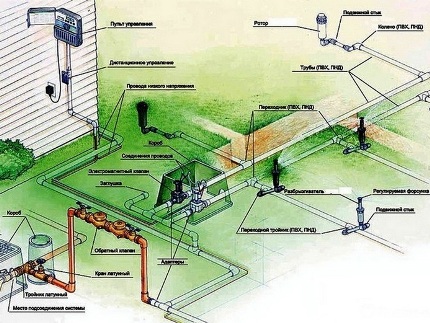
By the method of water supply, three types of non-manual irrigation systems are distinguished:
- Drop surface.
- Intrasoil
- Sprinkling (spraying).
The technology of creating "artificial rain" is the most common. To install such a system in a summer cottage, it is necessary to install several rotary sprinklers and bring water pipes to them. However, such sprinklers spend too much water.
Part of it simply evaporates before it reaches the soil. This type of country irrigation is mainly intended for watering large lawns.
Two other options for automatic irrigation systems include the supply of moisture to or onto the soil directly next to the plant to be watered. For this, perforated pipes, droppers and bubblers are used. A similar method of irrigation is more economical in terms of water consumption, but because of the large length of the water pipes are more expensive in the device.
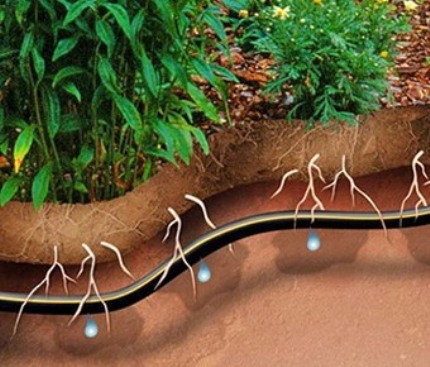
All selection details pipes for drip irrigation You will find in an article on this interesting subject.
Pipes for all types of garden watering are selected by diameter in the range from 25 to 32 mm. If the pressure in the central water supply at the cottage is low or water is supplied to the system from the tank by gravity, then the cross-section should be closer to the upper boundary. Otherwise, you can save by taking pipes and fittings with a diameter of 25–27 mm.
At lower values, the pipeline will work inefficiently, watering the ground for too long. And with large sizes, it will prove to be an overly expensive pleasure. A stream of water will still only fill such a pipe halfway. A large-diameter pipe products are obviously more expensive than their thinner counterparts.
Rules and guidelines selecting a hose for irrigation toultural plants and green spaces in the summer cottage are outlined in the article, which we recommend reading.
Features of metal water pipes
Products made of polymer compounds are now widely used. This material does not rust, cheap and easy to install. But metal is also not being written off.
At domestic cottages, you can find a lot of metal water pipes used to irrigate plantings on the site. In many respects, this is a legacy of the Soviet era, when there were simply no polymer pipes. However, not everything is so simple, the metal has a lot of advantages.
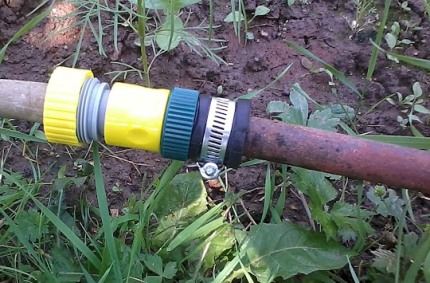
Among the advantages of irrigation pipes of their metal are:
- fracture resistance;
- frost resistance;
- long service life of 20-30 years;
- high mechanical strength.
Metal water conduits can be safely laid under pedestrian walkways and areas near the garage where vehicles are installed. They will not break under pressure from above. They can bend, but not break.
Polymeric products are unlikely to withstand such loads. Polymer pipes are too fragile compared to metal pipes. And in winter, water pipes assembled from them without insulation on the street are better not to operate at all.
Metal pipes for organizing watering in the country are made of suitable materials:
- steel;
- galvanized steel;
- copper.
The main disadvantage of the first option is its high susceptibility to corrosion. When in the ground, the steel pipeline inside and out begins to rust quickly. The use of galvanized stainless steel with greater corrosion resistance allows you to extend the life of such a conduit, but leads to a significant increase in its cost.
Rust is not a problem for copper pipes, but they cost a lot. Plus, we must not forget about the problem of theft. Not all holiday villages are protected. And copper is a welcome boot for uninvited visitors visiting other people's empty cottages in the winter with the aim of theft. It will always be in price at the scrap metal purchase bases.
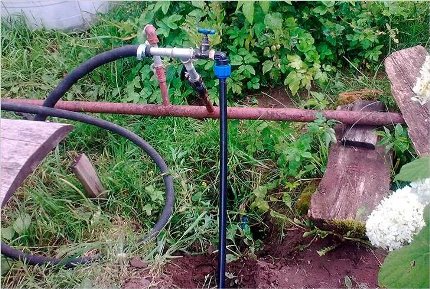
Often, an irrigation system is laid in the ground. Digging it up for the winter means loading yourself with extra work. Usually it is preserved and remains in the ground. But plastic becomes brittle during frosts, which often leads to its destruction.
And steel and copper calmly tolerate negative temperatures. Pipes from them can be safely left in the ground for the winter. It is only necessary to drain the water from the cold.
With marking and assortment fittings for connecting steel pipes The following article, which we recommend reading, will introduce you.
Overview of polymer pipes for cottages
There are several types of pipes made of plastic, which vary greatly in characteristics. Some of them can be used for watering at the cottage all year round, while others can be used only in summer and autumn until frost. Some are recommended to be laid on the ground, while others should be buried in it to protect the pipeline from direct sunlight.
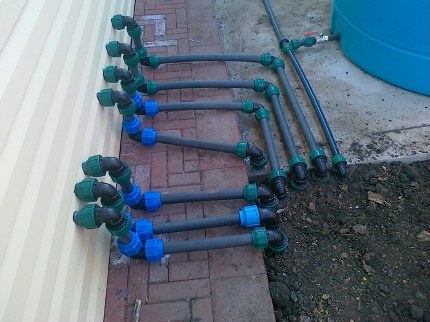
The assembly of polymer pipes for irrigation system irrigation in the country should not cause problems. Do it yourself. Plastic is lightweight, easy to cut and join. It is only necessary to correctly draw up a diagram of the pipeline, accurately calculating the required number of fittings and footage of pipe products.
Option # 1: Polyethylene (PE)
The first in polarity and durability are low-pressure polyethylene (HDPE) pipes. The term "low pressure" here means the manufacturing technology of a plastic product, and not the performance of the pipeline.PE is quite suitable not only for a low-pressure country water conduit, but is also widely used in the installation of heating and domestic hot water.

In stores you can find products from cross-linked polyethylene with the marking PEX. Such pipes have higher strength characteristics, but also a higher price. Acquiring them for irrigation water in the country is impractical. There are cheaper analogues that can cope with the task of supplying water for watering the garden without problems.
In comparison with other plastic pipes, polyethylene is more:
- flexible and elastic;
- resistant to ice formation (do not burst);
- strong on a gap and a bend;
- the roads.
Operating temperature of polyethylene pipes - from -70 to +800C. They are not afraid of frost. The irrigation system from them will calmly winter in the ground, and in the spring it will begin to work without any problems and additional tricks.
Connect HDPE pipes by welding and using fittings. Use the first method in the country is not worth it. The irrigation system in this case is non-separable. Plus, for work, you will need to buy or rent a special soldering iron, which you need to spend extra money on. This option is more for home water supply systems. It is better to use compression fittings.
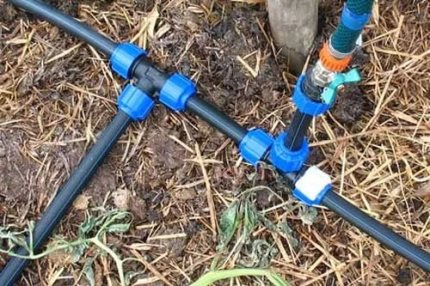
Another plus in favor of the choice for organizing watering at the cottage of polyethylene pipes is their resistance to ultraviolet radiation. The irrigation system of them can be made superficial by laying it on the soil.
PE pipe walls will not collapse under the sun. It is impossible to say similar things about other polymer pipelines. They are not at all friendly with ultraviolet rays.
Option # 2: Polypropylene (PP)
Compared to the first option, polypropylene pipes are more resistant to high temperatures, but do not tolerate cold. They are mainly used for the installation of heating systems. But for watering the garden, they are also quite applicable.
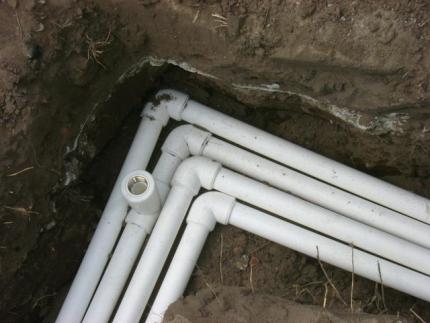
Most often PP pipes are connected by fittingsproduced by soldering or cold welding. To do this, their ends are heated to 260 degrees so that the polymer begins to melt, and then the connecting part is inserted. After cooling, such a joint turns into a monolith, which is difficult to break.
The system of garden watering from polypropylene pipes refers to a non-separable type. And given that this plastic is not afraid of ultraviolet radiation, especially black products with enhanced UV protection, it also does not need to be buried in the ground or covered from the sun.
Plus, the use of fittings and diffuse soldering technology complicates installation work. Polypropylene is not the easiest and most convenient option for a summer residence.
By the high cost of the pipe, PP loses to its polyethylene counterpart.However, fittings for it (tees, transitions, turns) are several times cheaper than those that are needed to connect PE products. Polypropylene pipelines, on the other hand, are more durable. Being in the ground, they are able to withstand the weight of a person and not break.
Option # 3: Polyvinyl Chloride (PVC)
The cheapest option is polyvinyl chloride (PVC). These pipes are characterized by low resistance to ultraviolet radiation. But the sun should not be left for a long time. Frosts are not so bad for them as for polypropylene products. But at low temperatures they become more fragile and are easily damaged by a gentle blow.
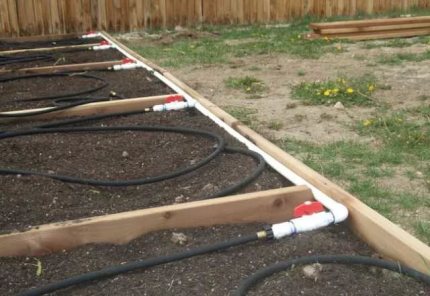
Fittings and special glue are used to connect the PVC pipeline. The general installation technology is comparable to the polypropylene version, only to soften the polymer instead of high temperature adhesive is used. The resulting water conduit is non-separable.
If the pipeline for watering the garden of polyvinyl chloride is not protected from the sun, then it will not last long. With prolonged exposure to sunlight in this polymer compound, photodestruction begins. As a result, the product from it becomes less durable and ductile. PVC water walls are made harder and more brittle.
For installation of irrigation in the country, PVC pipes should be taken in dark color.They contain additives that increase resistance to UV. And the sun does not directly affect the water in such a highway, which reduces the risk of overgrowth inside the algae.
Regardless of the type of polymer pipe chosen, autowatering from it can be done by yourself. The main thing here is to weigh all the pros and cons of each plastic, without exception. The cheapest option may be both the most successful investment of money, and their waste.
If mistakes are made during the selection of consumables and installation, then the garden conduit for irrigation will not last long.
Often, the main line of such a pipeline is made of stainless steel, and bends to beds and trees are made of polymers in a detachable design. By winter, these polymer pipes can be removed and stored. Such a system will be the most durable and reliable.
Conclusions and useful video on the topic
The following video materials will help you navigate the various types of polymer pipes, which are most often used in the installation of automatic and semi-automatic irrigation systems in the country.
Video # 1. The organization of drip irrigation in the garden with your own hands:
Video # 2. Installation technology of polymer water supply for irrigation of beds in the country:
Video # 3. In detail about polyethylene water pipes:
For the device of watering in the country garden requires very little time. But how much energy will be saved. Pipes for such a system can be used both metal and plastic.
Their choice largely depends on the technology of soil moisture. Making holes for irrigation in a steel product is still a pleasure. Of polymer products, polyethylene will last the longest. But if at the forefront is the cheapness of execution, then it is worth choosing PVC.
Tell us about how and from which pipes you assembled an irrigation system in a summer cottage. Perhaps you have information that will be useful to visitors to the site. Please write comments in the block below, ask questions, publish photos on the topic of the article.

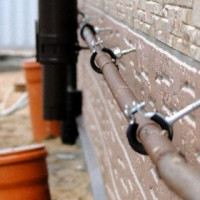 Pipe Clamps: Species Overview and Installation Instructions
Pipe Clamps: Species Overview and Installation Instructions 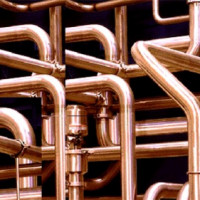 Connecting copper pipes: instructions and comparison of various installation technologies
Connecting copper pipes: instructions and comparison of various installation technologies 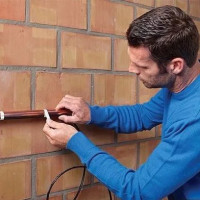 Self-regulating heating cable: overview of types and features of use
Self-regulating heating cable: overview of types and features of use 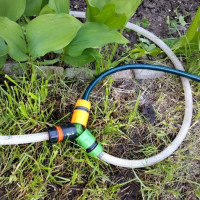 Pipe for drip irrigation: what to look for when choosing + rules for working with it
Pipe for drip irrigation: what to look for when choosing + rules for working with it 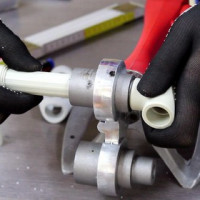 DIY welding technology for polypropylene pipes: an overview of methods and nuances
DIY welding technology for polypropylene pipes: an overview of methods and nuances 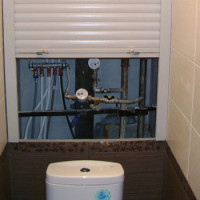 How to arrange a pipe box in the toilet: an overview of the best ways to mask the pipeline
How to arrange a pipe box in the toilet: an overview of the best ways to mask the pipeline  How much does it cost to connect gas to a private house: the price of organizing gas supply
How much does it cost to connect gas to a private house: the price of organizing gas supply  The best washing machines with dryer: model rating and customer tips
The best washing machines with dryer: model rating and customer tips  What is the color temperature of light and the nuances of choosing the temperature of the lamps to suit your needs
What is the color temperature of light and the nuances of choosing the temperature of the lamps to suit your needs  Replacement of a geyser in an apartment: replacement paperwork + basic norms and requirements
Replacement of a geyser in an apartment: replacement paperwork + basic norms and requirements
Parents live in a country house. With age, it is increasingly difficult for them to take care of the vegetation of their land in the summer, so the husband made him universal AUTO watering.
For the introduction and operation of this system, he used pipes (perforated), bubblers and droppers. Parents are very happy with this “service”, its appearance greatly facilitated their work, automatic watering has become a good helper. The only drawback is that it turned out a little expensive for the money.
I am not a fan of plastic, and I absolutely dislike the current tendency to replace everything with polymers everywhere. But here I am right here with both hands for plastic pipes, although metal ones are attractive because they are stronger. I have polyethylene pipes in my area. Yes, they are more expensive than other plastic ones, but they are also more reliable. I stepped on them more than once; nothing breaks there. A car and pedestrian paths with a garden water supply do not intersect.
Watering through sprinklers really hits the family budget. Cucumbers with tomatoes are almost gold. Therefore, in this way I watered my garden for only one summer. I looked at the accounts and realized that I needed to change the system. Now I have drip irrigation in the area.The option when the pipes are buried in the soil, I dismissed - this perforation, according to friends, is quite often clogged. Too much trouble for aesthetics.
And at the end of the season, I take apart the entire system, rinse, dry and put it in storage until next spring. I don’t really understand what kind of frost damaging the pipes they write here. How do you plow your vegetable gardens in the fall if the pipes remain on the site?
At the expense of how to plow the garden in the fall, when drip irrigation is installed, then everything is simple - you need to dismantle it. That is, I always install drip irrigation in such a way that at the end of the season it can be easily and quickly disassembled, I wind the hoses on coils with special ones, plus each hose is numbered.
And in the greenhouse it’s already easier: most of them are installed permanently, but if necessary, the system is easily upgraded or moved. As a container I use an old cast-iron bath (for greenhouses), for a plastic garden - Eurocubes.
Yes, I also think that you can’t imagine better than HDPE pipes for watering a garden. I plan to make a drip irrigation system. The inconvenience is that the water in the village is given three days a week, so we collect it into the tank. I’m not sure what it will turn out to do by gravity without a pump.